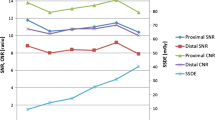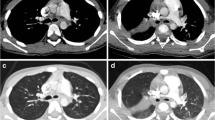Abstract
To compare tube current adaptation based on 3 body mass index (BMI) categories versus anterior-posterior chest diameter (APD) for radiation dose optimisation in patients undergoing dynamic volume cardiac CT. Two cardiac imaging centres participated in the study. 20 patients underwent a prospectively triggered 320-slice single beat cardiac CT using the X-ray tube current [mA] manually adjusted to the patient’s BMI (group I). In 20 subsequent patients, the tube current was adapted according to the patient’s APD (group II). All other parameters were kept constant. Image noise was defined as the standard deviation of attenuation values and measured using a ROI in the descending aorta. Variation in image noise was statistically compared between both patient groups. Average and standard deviation of pixel noise were 29.1 HU and 14.8 HU in group I and 28.0 HU and 4.2 HU in group II. Inter-individual variation of pixel noise was significantly lower in group II compared to group I (p < 0.0001). Tube current adaptation based on APD is superior to stepwise adaptation based on BMI for optimising radiation dose in dynamic volume cardiac CT and therefore limits unnecessary radiation dose while ensuring diagnostic image quality in patients with diverse body habitus.




Similar content being viewed by others
References
Einstein AJ, Henzlova MJ, Rajagopalan S (2007) Estimating risk of cancer associated with radiation exposure from 64-slice computed tomography coronary angiography. JAMA 298(3):317–323
Gies M, Kalender WA, Wolf H, Suess C (1999) Dose reduction in CT by anatomically adapted tube current modulation. I. Simulation studies. Med Phys 26(11):2235–2247
Lee EJ, Lee SK, Agid R, Howard P, Bae JM, terBrugge K (2009) Comparison of image quality and radiation dose between fixed tube current and combined automatic tube current modulation in craniocervical CT angiography. AJNR Am J Neuroradiol 30(9):1754–1759. doi:10.3174/ajnr.A1675
Catalano C, Francone M, Ascarelli A, Mangia M, Iacucci I, Passariello R (2007) Optimizing radiation dose and image quality. Eur Radiol 17(Suppl 6):F26–F32
Horiguchi J, Matsuura N, Yamamoto H et al (2009) Evaluation of attenuation-based tube current control in coronary artery calcium scoring on prospective ECG-triggered 64-detector CT. Acad Radiol 16(10):1231–1240. doi:10.1016/j.acra.2009.04.008
Tsukagoshi S, Ota T, Okumura M, Muramatsu Y, Johkoh T (2006) Simulator-assisted setting of scan protocols for X-ray CT: development and clinical usefulness of the Scan Plan Simulator. Nippon Hoshasen Gijutsu Gakkai Zasshi 62(1):95–104
Okumura M, Ota T, Kainuma K, Sayre JW, McNitt-Gray M, Katada K (2008) Effect of edge-preserving adaptive image filter on low-contrast detectability in CT systems: application of ROC analysis. Int J Biomed Imaging 2008:379486
Alessandri N, Di Matteo A, Rondoni G et al (2009) Heart imaging: the accuracy of the 64-MSCT in the detection of coronary artery disease. Eur Rev Med Pharmacol Sci 13(3):163–171
Leber AW, Knez A, von Ziegler F et al (2005) Quantification of obstructive and nonobstructive coronary lesions by 64-slice computed tomography: a comparative study with quantitative coronary angiography and intravascular ultrasound. J Am Coll Cardiol 46(1):147–154
Lehman SJ, Abbara S, Cury RC et al (2009) Significance of cardiac computed tomography incidental findings in acute chest pain. Am J Med 122(6):543–549
Hamon M, Biondi-Zoccai GG, Malagutti P et al (2006) Diagnostic performance of multislice spiral computed tomography of coronary arteries as compared with conventional invasive coronary angiography: a meta-analysis. J Am Coll Cardiol 48(9):1896–1910
Kapoor D, Thompson RC (2009) Diagnostic accuracy of CT coronary angiography. Cardiol Clin 27(4):563–571
Rogalla P, Kloeters C, Hein PA (2009) CT technology overview: 64-slice and beyond. Radiol Clin North Am 47(1):1–11. doi:10.1016/j.rcl.2008.10.004
European Study Group of Radiologists and Physicists (1999) European guidelines on quality criteria for computed tomography. EUR 16262 EN
Brooks RA, Di Chiro G (1976) Statistical limitations in X-ray reconstructive tomography. Med Phys 3(4):237–240
Paul JF, Abada HT (2007) Strategies for reduction of radiation dose in cardiac multislice CT. Eur Radiol 17(8):2028–2037
Rixe J, Conradi G, Rolf A et al (2009) Radiation dose exposure of computed tomography coronary angiography: comparison of dual-source, 16-slice and 64-slice CT. Heart 95(16):1337–1342. doi:10.1136/hrt.2008.161018
Steigner ML, Otero HJ, Cai T et al (2009) Narrowing the phase window width in prospectively ECG-gated single heart beat 320-detector row coronary CT angiography. Int J Cardiovasc Imaging 25(1):85–90. doi:10.1007/s10554-008-9347-8
Deurenberg P, Weststrate JA, Seidell JC (1991) Body mass index as a measure of body fatness: age- and sex-specific prediction formulas. Br J Nutr 65(2):105–114
Herzog BA, Husmann L, Valenta I et al (2009) Determinants of vessel contrast in BMI-adapted low dose CT coronary angiography with prospective ECG-triggering. Int J Cardiovasc Imaging 25(6):625–630. doi:10.1007/s10554-009-9460-3
Husmann L, Herzog BA, Burkhard N et al (2009) Low-dose coronary CT angiography with prospective ECG triggering: validation of a contrast material protocol adapted to body mass index. AJR Am J Roentgenol 193(3):802–806. doi:10.2214/AJR.08.2052
Rybicki FJ, Otero HJ, Steigner ML et al (2008) Initial evaluation of coronary images from 320-detector row computed tomography. Int J Cardiovasc Imaging 24(5):535–546. doi:10.1007/s10554-008-9308-2
Mayo JR, Leipsic JA (2009) Radiation dose in cardiac CT. AJR Am J Roentgenol 192(3):646–653
Feuchtner GM, Jodocy D, Klauser A et al. (2009) Radiation dose reduction by using 100-kV tube voltage in cardiac 64-slice computed tomography: a comparative study. Eur J Radiol. doi:10.1016/j.ejrad.2009.07.012
Li X, Samei E, Segars WP, Sturgeon GM, Colsher JG, Frush DP (2008) Patient-specific dose estimation for pediatric chest CT. Med Phys 35(12):5821–5828
Author information
Authors and Affiliations
Corresponding author
Rights and permissions
About this article
Cite this article
Rogalla, P., Blobel, J., Kandel, S. et al. Radiation dose optimisation in dynamic volume CT of the heart: tube current adaptation based on anterior–posterior chest diameter. Int J Cardiovasc Imaging 26, 933–940 (2010). https://doi.org/10.1007/s10554-010-9630-3
Received:
Accepted:
Published:
Issue Date:
DOI: https://doi.org/10.1007/s10554-010-9630-3




